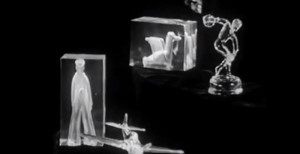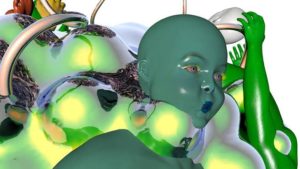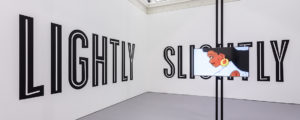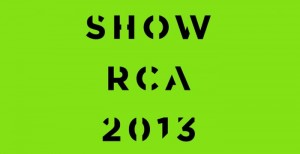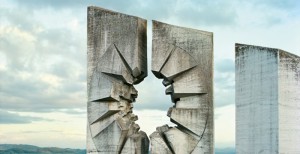Haroon Mirza’s o/o/o/o installations at Lisson Gallery visualise minimalistic production processes, run electric dreams between sonic mechanisms, amplify insect movements across reverb chambers, and throw broken samples into site-specific wave patterns.
Industrial, stripped-back, bare, it is an exhibition where echoes of the minimal artist’s practice is laid bare. Squared to the entrance, ‘Untitled 2013’ visually marks out a borrowed aesthetic. Small and rectangular, divided into one green half and another blue segment composed from a series of commercially available LED lights, it clearly mirrors Dan Flavin’s use of readymade fluorescent lights, made up as luminescent sculptures in national art galleries. It’s famous, beyond the walls of most private contemporary collections and deliberately so.
Located within Lisson Gallery, ‘Sitting in a Chamber 2013’ takes a conceptual cue. Its homemade records spun over turntables reminiscent of Christian Marclay’s earlier Recycled Records played over decks as instrumentation, is a video work interacting with samples onscreen, close to ‘Telephones’ (1995)’s own mastery of sound and visual experimentation. Ideas and forms acquired from artists Mirza clearly admires, sampled and mixed together anew.

It is a blatant use. Like much house music, on which Mirza places great value, it is purposefully self-referential. A wall of noise for those new to the club but a new cut of sounds referential to genres, scenes, places, people, emotions and more, for those in the know. Here, Mirza produces a new track, made up out of sampled bass lines, high notes and rhythms, and at the same time a new artwork edited out of visual cues, concepts and sounds.
Importantly, sound is deconstructed visually. A video piece, part of ‘Sitting in a Chamber’ (2013) shows us a filmed screen shots of Audacity, a sequencer programme, on which the word “speech”, spoken out loud as a vocal and “articulated by speech” as an acapella, is looped into oblivion. Electronic music’s production process distorted first hand.
Interactively, in ‘Adam, Eve, others and a UFO’ (2013) visible speakers placed in a circle around a faux studio room invite visitors to walk though a mapped-out track. Architecturally, in ‘Pavilion for Optimisation’ (2013), a chamber created in collaboration with his brother Omar Mirza is a space is created where echoes from samples of a shower and an ant are overblown live in sequence to a light that floods the space with a powerful effect. Online ‘o-o-o-o.co.uk’ allows for samples from the show to be downloaded, remixed and uploaded in a cycle without a potential end.
Where Mirza panders to highly conceptual pieces of work, he excels. Reference to Alvin Lucier’s 1969 piece, ‘I am sitting in a room’, insatiably produce a worthy back catalogue of footnotes. As an exhibition, however. o/o/o/o condescends in its attempt to link avant-garde composition with underground electronic dance music. Punk-rock aggression sanitised and sequenced, house music’s groove lost.
Haroon Mirza’s /o/o/o/o/, is running at Lisson Gallery from May 17 to June 29, 2013.
Header image: Haroon Mirza, ‘Adam, Eve and a UFO’ (2013) Active speakers, UFO circuit, cables. Image courtesy of the artist and Lisson Gallery.

